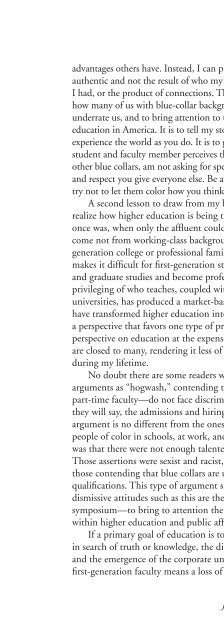WINTER 2012 - National Association of Schools of Public Affairs and ...
WINTER 2012 - National Association of Schools of Public Affairs and ...
WINTER 2012 - National Association of Schools of Public Affairs and ...
You also want an ePaper? Increase the reach of your titles
YUMPU automatically turns print PDFs into web optimized ePapers that Google loves.
Patricia Shields, N<strong>and</strong>hini Rangarajan, <strong>and</strong> Lewis Stewart<br />
Research purpose.<br />
The two-course sequence that distinguishes the Texas State University<br />
capstone process is unique because students are required to find a research topic<br />
<strong>and</strong> develop their purpose <strong>and</strong> conceptual framework in specific ways. Students<br />
must use one <strong>of</strong> the following five research purposes—exploration, description,<br />
gauging, decision making, or explanation. Of the five, explanation is the only<br />
one that addresses the more complex “why” questions. It is also the research<br />
purpose associated with hypotheses testing, impact evaluation, <strong>and</strong> multivariate<br />
statistical analysis. If explanation is considered the most sophisticated research<br />
purpose by many, then one would expect there to be more interest among the<br />
public in downloading those ARPs with an explanatory research purpose. Hence:<br />
H2: Use <strong>of</strong> an explanatory research purpose positively affects<br />
the number <strong>of</strong> full-text downloads for ARPs.<br />
Survey research.<br />
Surveys are particularly useful in describing the characteristics <strong>of</strong> a large<br />
population. Therefore, it is the generalizable nature <strong>of</strong> survey results that could<br />
potentially increase download rates. Hence:<br />
H3: Use <strong>of</strong> surveys as a research method positively affects<br />
the number <strong>of</strong> full-text downloads for ARPs.<br />
Award winner.<br />
One would expect that higher-quality research would be downloaded at<br />
higher numbers. One measure <strong>of</strong> quality is an award. Hence:<br />
H4: Winning awards positively affects the number <strong>of</strong><br />
full-text downloads for ARPs.<br />
Search Engine Optimization<br />
Aside from content, there are characteristics <strong>of</strong> the paper that enhance the<br />
likelihood a search engine could find it. For example, the longer an ARP is<br />
on the repository, the more likely it is to be found <strong>and</strong> downloaded. Hence,<br />
the longer an ARP is available on the institutional repository, the greater the<br />
opportunity for downloads. If a popular keyword is in the title, the paper is more<br />
likely to be downloaded. Two-part titles are more likely than one-part titles to<br />
contain one <strong>of</strong> these words.<br />
Google Scholar is a popular search engine for academic work. Google<br />
Scholar archives academic work, including dissertations, theses, <strong>and</strong> Applied<br />
Research Projects. Each Google Scholar entry gives the number <strong>of</strong> citations for<br />
each reference within the Google Scholar database; <strong>and</strong> citations <strong>of</strong> theses <strong>and</strong><br />
ARPs are counted. Hence, every entry in an ARP’s bibliography is counted as<br />
a citation in Google Scholar for the associated reference. Therefore, one would<br />
expect ARPs with larger bibliographies to generate more downloads. Texas State<br />
166 Journal <strong>of</strong> <strong>Public</strong> <strong>Affairs</strong> Education

















